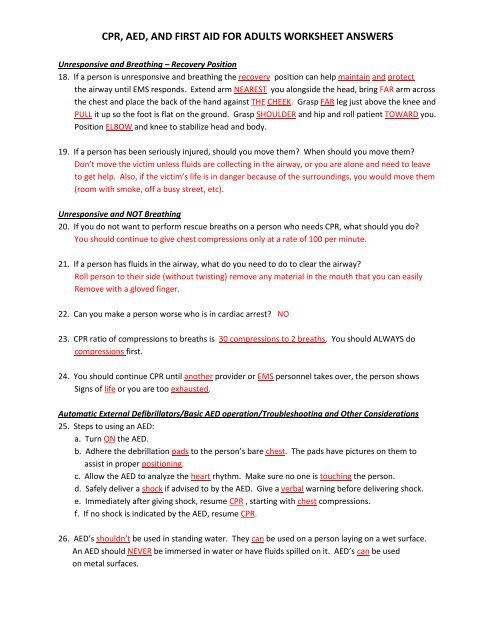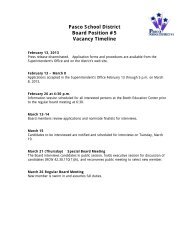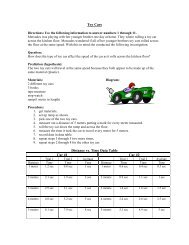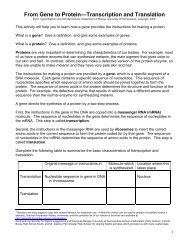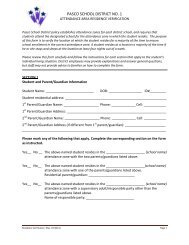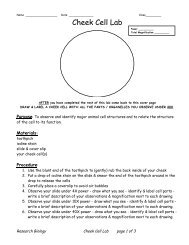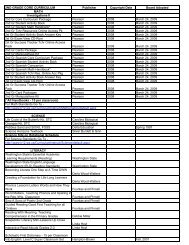CPR, AED, AND FIRST AID FOR ADULTS WORKSHEET ANSWERS
CPR, AED, AND FIRST AID FOR ADULTS WORKSHEET ANSWERS
CPR, AED, AND FIRST AID FOR ADULTS WORKSHEET ANSWERS
Create successful ePaper yourself
Turn your PDF publications into a flip-book with our unique Google optimized e-Paper software.
<strong>CPR</strong>, <strong>AED</strong>, <strong>AND</strong> <strong>FIRST</strong> <strong>AID</strong> <strong>FOR</strong> <strong>ADULTS</strong> <strong>WORKSHEET</strong> <strong>ANSWERS</strong><br />
Unresponsive and Breathing – Recovery Position<br />
18. If a person is unresponsive and breathing the recovery position can help maintain and protect<br />
the airway until EMS responds. Extend arm NEAREST you alongside the head, bring FAR arm across<br />
the chest and place the back of the hand against THE CHEEK. Grasp FAR leg just above the knee and<br />
PULL it up so the foot is flat on the ground. Grasp SHOULDER and hip and roll patient TOWARD you.<br />
Position ELBOW and knee to stabilize head and body.<br />
19. If a person has been seriously injured, should you move them? When should you move them?<br />
Don’t move the victim unless fluids are collecting in the airway, or you are alone and need to leave<br />
to get help. Also, if the victim’s life is in danger because of the surroundings, you would move them<br />
(room with smoke, off a busy street, etc).<br />
Unresponsive and NOT Breathing<br />
20. If you do not want to perform rescue breaths on a person who needs <strong>CPR</strong>, what should you do?<br />
You should continue to give chest compressions only at a rate of 100 per minute.<br />
21. If a person has fluids in the airway, what do you need to do to clear the airway?<br />
Roll person to their side (without twisting) remove any material in the mouth that you can easily<br />
Remove with a gloved finger.<br />
22. Can you make a person worse who is in cardiac arrest? NO<br />
23. <strong>CPR</strong> ratio of compressions to breaths is 30 compressions to 2 breaths. You should ALWAYS do<br />
compressions first.<br />
24. You should continue <strong>CPR</strong> until another provider or EMS personnel takes over, the person shows<br />
Signs of life or you are too exhausted.<br />
Automatic External Defibrillators/Basic <strong>AED</strong> operation/Troubleshooting and Other Considerations<br />
25. Steps to using an <strong>AED</strong>:<br />
a. Turn ON the <strong>AED</strong>.<br />
b. Adhere the debrillation pads to the person’s bare chest. The pads have pictures on them to<br />
assist in proper positioning.<br />
c. Allow the <strong>AED</strong> to analyze the heart rhythm. Make sure no one is touching the person.<br />
d. Safely deliver a shock if advised to by the <strong>AED</strong>. Give a verbal warning before delivering shock.<br />
e. Immediately after giving shock, resume <strong>CPR</strong> , starting with chest compressions.<br />
f. If no shock is indicated by the <strong>AED</strong>, resume <strong>CPR</strong>.<br />
26. <strong>AED</strong>’s shouldn’t be used in standing water. They can be used on a person laying on a wet surface.<br />
An <strong>AED</strong> should NEVER be immersed in water or have fluids spilled on it. <strong>AED</strong>’s can be used<br />
on metal surfaces.


